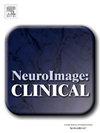使用脑电图和脑磁图的听觉感觉处理测量预测单音模式首发精神病的症状恢复。
IF 3.4
2区 医学
Q2 NEUROIMAGING
引用次数: 0
摘要
预测首发精神病(FEP)的症状进展对于定制治疗和改善结果至关重要。颞叶功能,由神经生理生物标志物如N100指示,预测症状进展并与未治疗的精神病相关。我们最近的报告显示,源定位脑磁图(MEG) M100对古怪范式音调的反应预测FEP阳性症状的恢复。这项研究用一个更简单的单音范式扩展了这些结果,同时使用了MEG和EEG,并测量了症状维度之间的关联。我们记录了29例FEP患者的MEG (M100)和EEG (N100),并使用阳性和阴性综合征量表(PANSS)在基线和~ 7个月后评估症状严重程度。序列回归分析预测了未治疗的活动性精神病(DAP)持续时间和基线M100的症状变化(ΔPANSS),控制了基线症状。用脑电图测量N100的子样本(n = 24)进行相同的回归。基线M100越小,随访时症状恢复越差,与基线症状严重程度无关。较长的DAP表现出类似的预测效果,但这种关系是由M100解释的。回归显示M100预测主要与一般精神病理有关。脑电图测得的N100也有相同的结果。FEP患者的颞叶功能障碍,特别是听觉感觉加工障碍,在一般精神病理中显示出较差的恢复轨迹。长期未经治疗的精神病使颞叶功能恶化,预示着较差的进展。通过脑电图和单音任务测量的N100可能是告知临床医生整体症状进展,指导治疗资源分配和干预措施的经济有效工具。本文章由计算机程序翻译,如有差异,请以英文原文为准。

Auditory sensory processing measures using EEG and MEG predict symptom recovery in first-episode psychosis with a single-tone paradigm
Predicting symptom progression in first-episode psychosis (FEP) is crucial for tailoring treatment and improving outcomes. Temporal lobe function, indicated by neurophysiological biomarkers like N100, predicts symptom progression and correlates with untreated psychosis. Our recent report showed that source-localized magnetoencephalography (MEG) M100 responses to tones in an oddball paradigm predicted recovery in FEP positive symptoms. This study expands these results with a simpler single-tone paradigm, with both MEG and EEG, and measuring associations across symptom dimensions. We recorded MEG (M100) and EEG (N100) in 29 FEP individuals and assessed symptom severity at baseline and after ∼ 7 months using the Positive and Negative Syndrome Scale (PANSS). Sequential regression analyses predicted symptom change (ΔPANSS) from Duration of untreated Active Psychosis (DAP) and baseline M100, controlling for baseline symptoms. Identical regressions were conducted in a subsample measuring N100 with EEG (n = 24). Smaller baseline M100 predicted worse symptom recovery at follow-up, independent of baseline symptom severity. Longer DAP showed a similar predictive effect, but this relationship was accounted for by M100. Regressions revealed M100 predictions were mostly related to general psychopathology. Identical results were found for N100 measured with EEG. Temporal lobe dysfunction in FEP, especially poor auditory sensory processing, indicates a worse recovery trajectory in general psychopathology. Longer untreated psychosis worsens temporal lobe function, predicting poorer progression. N100 measured with EEG and a single-tone task could be a cost-effective tool for informing clinicians about overall symptom progression, guiding treatment resource allocation and interventions.
求助全文
通过发布文献求助,成功后即可免费获取论文全文。
去求助
来源期刊

Neuroimage-Clinical
NEUROIMAGING-
CiteScore
7.50
自引率
4.80%
发文量
368
审稿时长
52 days
期刊介绍:
NeuroImage: Clinical, a journal of diseases, disorders and syndromes involving the Nervous System, provides a vehicle for communicating important advances in the study of abnormal structure-function relationships of the human nervous system based on imaging.
The focus of NeuroImage: Clinical is on defining changes to the brain associated with primary neurologic and psychiatric diseases and disorders of the nervous system as well as behavioral syndromes and developmental conditions. The main criterion for judging papers is the extent of scientific advancement in the understanding of the pathophysiologic mechanisms of diseases and disorders, in identification of functional models that link clinical signs and symptoms with brain function and in the creation of image based tools applicable to a broad range of clinical needs including diagnosis, monitoring and tracking of illness, predicting therapeutic response and development of new treatments. Papers dealing with structure and function in animal models will also be considered if they reveal mechanisms that can be readily translated to human conditions.
 求助内容:
求助内容: 应助结果提醒方式:
应助结果提醒方式:


